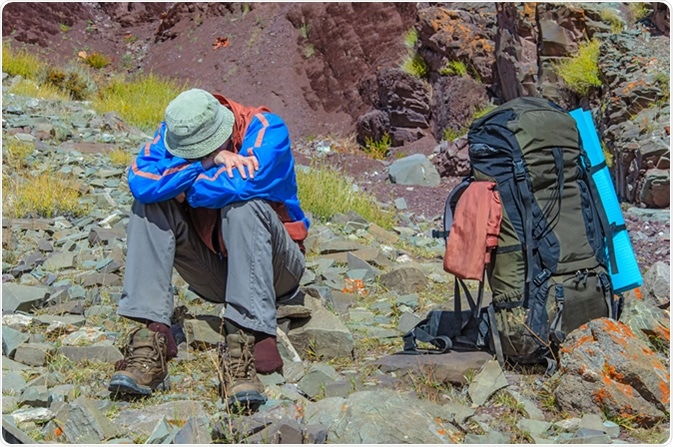There are many reasons why people ascend to high altitudes, from travel, leisure and sport to making permanent homes at altitude. Some people are more susceptible to altitude sickness, a condition caused by exposure to low oxygen levels at high altitudes.
Ascending to high altitudes subjects the body to several significant changes, including decreases in temperature and ambient humidity, to a drop in barometric pressure (air pressure). The body can take some time to make the adjustments necessary to survive comfortably at altitude.
Altitudes above 8000 feet pose significant risks to the body and may result in dangerous symptoms from the ascent. Any symptoms experienced at high altitude can quickly develop into life-threatening problems and should not be dismissed.

Altitude Sickness. Image Credit: Rosliak Oleksandr / Shutterstock
Forms of Altitude Sickness
The most dangerous consequences of altitude sickness are coma and death, but not all forms of altitude sickness are equally dangerous. There are three types of acute altitude sickness:
Acute Mountain Sickness (AMS)
Acute mountain sickness is typically the least life-threatening form of altitude sickness. The main symptom is headache, but other symptoms include:
- Dizziness
- Fatigue
- Nausea
- Insomnia
- Lassitude (a state of mental and physical fatigue)
High-Altitude Cerebral Edema (HACE)
In this form, the brain accumulates extra fluid and swells, impairing its ability to function normally. The exact cause of HACE is unknown, but it is hypothesized that hypoxia (oxygen deprivation) leads to neurohumoral and hemodynamic responses in the brain, causing leaks from microvascular beds and edema. HACE is characterized by:
- Ataxia (loss of control over body movements)
- Severe headache
- Fatigue
- Confusion
- Decline or loss of consciousness
- Difficulty speaking
- Seizures
High-Altitude Pulmonary Edema (HAPE)
This reaction to altitude can be asymptomatic and is related to HACE. With HAPE, fluid enters the lungs. This occurs because of a leak in the alveolar-capillary membrane caused by excessive hypoxia. HAPE is characterized by:
- Non-productive cough
- Reduced exercise performance
- Dyspnea (difficulty breathing after exertion or at rest)
- Orthopnea (shortness of breath when lying flat)
High Altitude Illness
Risk Factors
Risk factors associated with AMS include:
- Age
- Gender
- Overall physical health
- Pre-existing diseases
- Genetic make-up
- Hemoglobin saturation
- Pre-acclimatization
- Previous experience at altitude
- Home elevation
- Rate of ascent
Prevention
There are several pharmacological and non-pharmacological measures that can be taken to prevent acute altitude sickness.
Slowing ascent
Ascending to high altitudes too quickly remains the main risk factor for developing altitude sickness. Therefore, it is recommended that for ascents above 2500-3000 meters, sleeping elevation should not be increased by more than 300-600 meters per night, and a period of rest should be taken every three to four days, sleeping at the same elevation for one additional night. However, environmental or logistical factors may prevent this method from being effective in every situation, so those ascending to altitude are advised to average their ascent rate across the entire duration of the trip.
Diet
It is not recommended to consume excessive amounts of alcohol or opiate pain medications before ascending to altitude.
Exercise and exertion
The alveolar-arterial pressure difference widens progressively with increasing exercise, leading to reduced hemoglobin saturation at altitude, with an increase in the risk and severity of AMS. To decrease the risk of AMS, strenuous exercise and over-exertion should be avoided immediately after rapid ascent to high altitude.
Pre-acclimatizing
Getting used to conditions at altitude by spending time at moderate altitudes can decrease the incidence of altitude sickness. Although studies regarding the benefits of this method have returned widely varied results, the risks it poses are thought to be minimal. Pre-acclimatization should be carried out as close to the ascent to high altitude as possible.
Medication
Medication to prevent altitude sickness is not necessary for low-risk circumstances. However, individuals can be assessed on their previous performances at altitude, and the specific environmental risk rates of the course and the plan for the trip, particularly regarding planned rest days and increases in sleeping elevation when at >2500-3000 meters, can be evaluated
Treatment
Descending to lower altitudes is the best treatment for every form of altitude sickness, but different treatment courses can be taken according to the individual’s type and severity of altitude sickness.
AMS
AMS is generally treated by stopping ascent. Nonsteroidal anti-inflammatory drugs can be beneficial for headaches. As dehydration can present the same symptoms as AMS, staying hydrated is also recommended. If symptoms persist, individuals should descend to 500-1000 meters.
HACE
If immediate descent is not possible, individuals with HACE should be placed on oxygen either via an oxygen tank or oxygen concentrator or by being placed in a portable hyperbaric chamber (a chamber that increases oxygen pressure and simulates the effect of a descent).
HAPE
The treatment for HAPE varies greatly, depending on whether an individual has access to care in a health facility. If health facilities cannot be accessed, descent to a lower elevation, oxygen supplements or treatment with portable hyperbaric chambers as well as a pulmonary vasodilator is recommended.
Further Reading